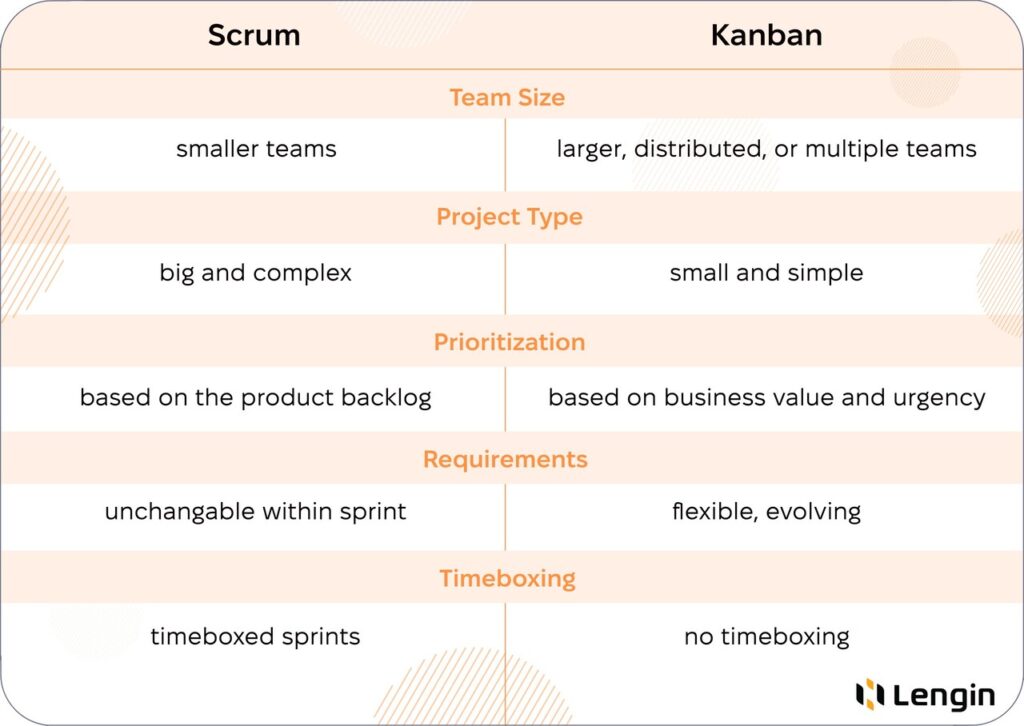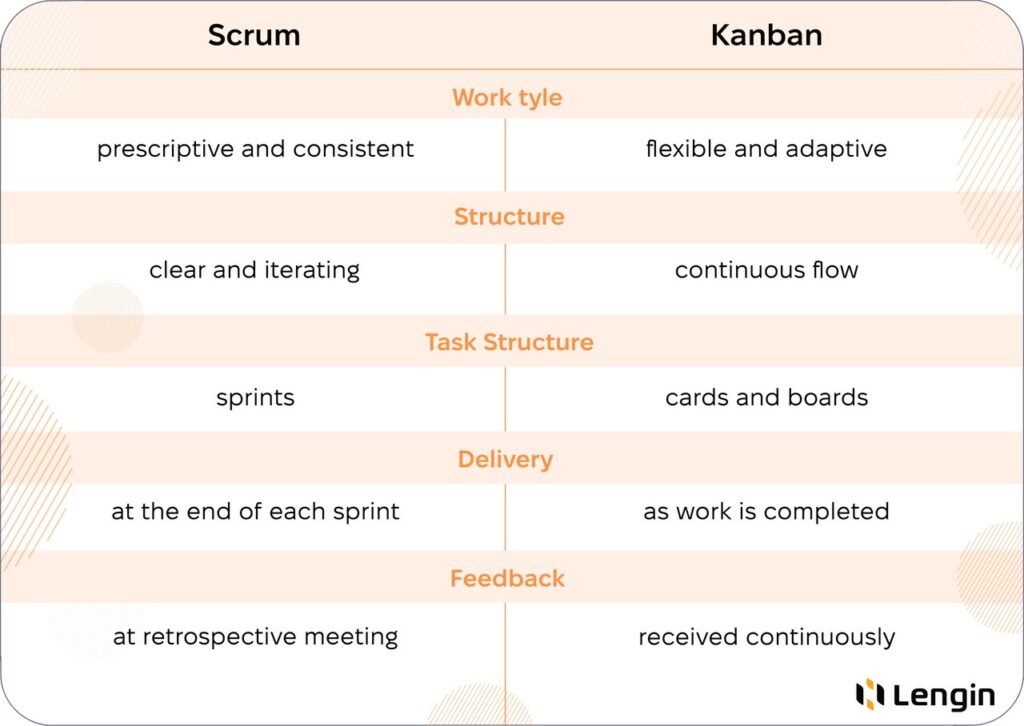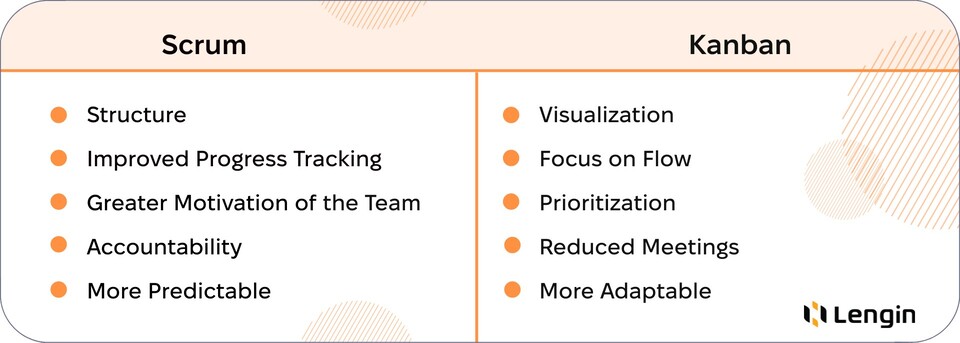Managing remote developer teams entails many difficulties. Communication challenges, unclear accountability, lack of visibility, and difficulties with progress tracking affect the team and the project. Sometimes, problems with managing the scope and setting the right priorities are added to the pile of various challenges.
There are two solutions: not to hire the remote development team and lose all the benefits of working with one, or choose the project management methodology that helps to overcome those barriers.
Agile methodologies are often the most beneficial choice with remote development teams. More than 71% of people who use Agile methods feel that it improves the delivery of their projects.
According to the statistics, almost 87% use Scrum, and 56% prefer Kanban. However, the decision should be made based on something other than popularity but objective comparison.
Table of Contents:
Scrum
Scrum is a framework for project management. Frameworks are complex, and so is Scrum. It focuses on strict structure and accountability by dividing work into smaller, manageable chunks called sprints, typically two to four weeks long.

Also, Scrum clearly identifies the roles: Development Team, Product Owner, and Scrum Master. In fact, a Scrum Master is a project or product manager who plays the role of an intermediate link between the other two.
This methodology heavily relies on communication, so the work is built on regular calls:
- Sprint begins with a planning meeting, where tasks are estimated and distributed.
- Daily stand-up meetings to track progress.
- Sprint review to present and assess results.
- Sprint retrospective to identify areas for improvement.
The ultimate goal is to deliver a potentially shippable product increment at the end of each sprint.
Kanban
Kanban focuses on visualizing work on a board, limiting work in progress, and continuously improving the flow of work rather than time frames and formalities. The goal is to increase efficiency, reduce waste, and deliver customer value faster.

Kanban doesn’t involve roles, ceremonies, artifacts, or formalities like Scrum. It relies on written communication that is quite effective with large teams because there is no need to gather 50 people in the meeting.
Kanban boards are divided into a few sections that represent stages of development. Some sections are the same for all projects:
- Backlog, where you gather ideas and notes for future implementation.
- To-do list, where you prioritize the tasks from the previous section and plan their execution.
- In-progress section for supervising current processes.
- Done section for finished tasks.
Sometimes, there are sections for reviewing, testing, debugging, testing, designing, and other processes you consider necessary. Kanban is all about flexibility.
Scrum vs Kanban
Scrum and Kanban are both robust agile methodologies that effectively manage remote developer teams. Nevertheless, each one works better with different projects and teams.

Pay attention to the requirements. In Scum, the client can’t change the requirements when they’ve already been fixed for a particular sprint. In Kanban, everything is flexible and can be changed at any moment.
That’s the biggest drawback of Scum. The results are presented at the end of the sprint, and if you don’t like them, you give your recommendations but have to wait 2-4 weeks to see what is done. Kanban is a flow, so your corrections are immediately taken to the work.

Also, the choice depends on how often you want to see results. Kanban is a continuous process, so you can see the outcome immediately when the task is completed.
Sometimes, the excessive flexibility of Kanban is a concern, and that’s why a lot of PMs prefer Scrum. It’s more structured, so reporting to the client is more effortless.
Key Takeaways
Both methodologies help manage remote development teams effectively, but which should you choose? Scrum provides a structured approach with defined roles and ceremonies, while Kanban offers flexibility and a visual workflow representation.
If the tables above are not enough, let’s look into their competitive advantages.

- Kanban’s visualization principles will help you understand the big picture better if you have a project with complex logic and multiple dependencies.
- For its part, Scrum is based on strict structurization and accountability with clear time frames. That guarantees high predictability in deadlines and results the client will receive at the end of each period. This way, progress tracking is a lot easier, too.
- Kanban also has structure but focuses more on overall efficiency rather than strict rules. First, it has the format of continuous flow so the client receives the results all the time and can give feedback, and the team starts working on that.
- With Scrum, the client has to wait till the end of the sprint to see all results. It takes a lot of work to grasp this much information and give all feedback at once. Also, the client’s recommendations become the backlog of the next sprint, so you have to wait till the finish again.
- In Scrum, each sprint finishes and starts with long meetings to discuss the mistakes of the previous sprint and plan the next one. Sounds time-consuming, isn’t it? With Kanban, the only reason for the meeting is a sudden disaster or actual necessity to discuss something. Kanban is based on principles of effectiveness and prioritization, so you will never see the full calendar of calls. It will look more like the pile of notifications.
- Closing each sprint brings the feeling of accomplishment that motivates the team to strive to make more results. The drawback is that it works only in the short term. After some time, the team feels the burden and pressure that leads to burnout and lower work quality.
If you are still trying to decide which one suits you, combine! However, pay attention to the fact that this approach often demands experienced project managers because of difficulties with implementation.